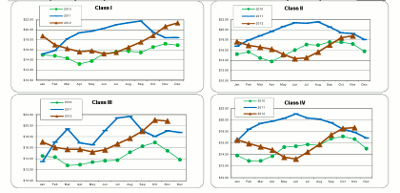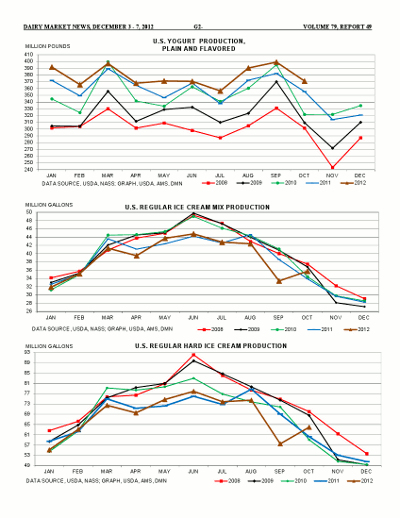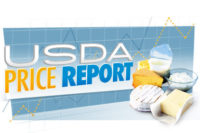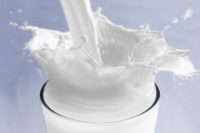These are highlights from USDA's Dairy Market News for the week of Dec. 3 to 7, 2012. Download the complete report here.
CHEESE HIGHLIGHTS: Milk supplies available for cheese manufacturing have increased and cheese plants are working additional hours to accommodate the increased volumes. The surge of milk from the holiday combined with increasing yields of fat and protein have built cheese inventories in the short run. Prices at the CME Group are steady to lower in daily trading this week. Blocks are mostly steady with barrels selling lower on most days. The block/barrel price spread on Thursday and Friday was a full 10 cents. Barrels closed the week unchanged at $1.6600 and blocks were unchanged at $1.7600. Buyers continue to place orders for immediate needs, but are cautious about building new inventories until price levels are better determined. The lower prices have increased inquiries from aging programs and export buyers, but sales remain slow.
FLUID MILK: Midwest farm milk production is increasing steadily, following typical November/December trends. Components are variable from week to week but processors indicate the overall trend on components shows a seasonal increase. Spot milk load availability increased substantially this week. Milk handlers point to two major reasons for the sudden increase in milk availability: cheese market volatility and mechanical issues at some Central plants.
 California milk production is slowly building along expected seasonal patterns. Overall production is behind year ago levels as dairy farmers continue to struggle with profitability issues. Fewer cows in the state and low cost rations have lowered production from last year. Manufacturing capacity is still above current milk supplies.
California milk production is slowly building along expected seasonal patterns. Overall production is behind year ago levels as dairy farmers continue to struggle with profitability issues. Fewer cows in the state and low cost rations have lowered production from last year. Manufacturing capacity is still above current milk supplies.
Arizona reports milk production is increasing slowly. Overall supplies are behind a year ago, but catching up. Favorable weather in New Mexico has boosted milk production slightly. Supplies are still below year ago levels. Fewer cows and lower cost rations are holding production back. Processors report adequate milk supplies for current needs.
Milk production in the Pacific Northwest remains near the seasonal bottom. Financial margin stress is not helping output to move higher very fast this fall/winter. Coastal moisture is making its way to Utah and Idaho. Any moisture is always welcomed in the High Plains region.
BUTTER HIGHLIGHTS: Butter prices increased on CME trading this Wednesday for the first time in 18 trading sessions and rose again Thursday, closing the week at $1.5900. Churning in the West is somewhat above expectations, where cream remains readily available and club store sales are excellent with heavier orders coming in. Central butter production is active, using primarily internal cream. Butter inventories are building seasonally but interest for December is sluggish and generally lower than projected by some manufacturers.



